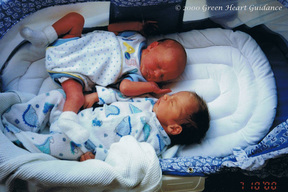 my twins at two days old
my twins at two days old
During my first pregnancy, I held out hope until fairly late that I might have twins, but my midwife was confident that I was having a singleton whom my intuition had correctly identified as a girl. My second pregnancy ended in a miscarriage at 5.5 weeks. With my third pregnancy, I had my hCG levels drawn very early, and they were normal. I elected not to have thetriple screen done at 14-16 weeks because of the high chance of false positives. My then-husband and I would not have terminated a pregnancy because of Down Syndrome, so we didn’t see the point.
My third pregnancy had not been easy, but my first had not been either. Carpal tunnel syndrome started for me at 10 weeks instead of the 20 weeks it had started at in the first pregnancy. Morning sickness was only seven weeks instead of 10, though. I was tired quite a bit, but that helped keep me on the couch working on my dissertation. One day while I was laying there on the couch at about seven weeks, I had a passing thought about "when the babies arrived." I mentally stopped myself, not sure why I had thought about my impending arrival in the plural, but I shook it off and went on with my dissertation work.
A few weeks later, I was driving on an entrance ramp to the highway when the thought went through my mind out of nowhere, “What if they are conjoined twins?” Again, I told myself I was crazy. There was nothing wrong with my baby, and I was only having one, not two. When I went to prenatal yoga a few weeks later, my instructor asked me if I knew the sex of the baby. I told her that it was a boy, but there was something else going on that I couldn’t pinpoint.
At 18 weeks, we went in for a sonogram to check on our baby. Given that our firstborn had died during delivery, I had spent the previous eight months researching infant loss and reading stories by other women who had lost their babies. If there was something that could go wrong, I knew about it. For many people, their first sign that something was wrong with their babies came during their initial sonogram. That knowledge was in the back of my mind as the sonographer put the probe on my abdomen. He held it there only for a second, and then he pulled it off and flew his rolling chair over to the adjacent desk. He began frantically flipping through my file, clearly not finding what he was looking for. I began to panic. What had he seen in that second that was concerning him so much? Finally he turned to us and asked, “Do you know that you’re having twins?”
After the sonogram, my then-husband and I went out to lunch, sitting there in stunned silence as we stared at each other contemplating what we had both been told. After the shock wore off, there was only joy. The only thing better than being blessed with one baby was to be blessed with two.
I carried my twins to term, and after an exciting delivery, they joined us in the world. The first six months were very rough, but our babies were worth every sleepless night we went through courtesy of their undiagnosed silent reflux. After they turned two, life became much easier. Now, as they reach 15, my twins are still an amazing source of joy in my world. Watching their unique sibling relationship evolve over the years has been fascinating to me.
Twins are becoming incredibly common in our world with the advances in fertility treatments. According to theCenter for Disease Control, “The rate of twin births in the United States reached a 33.7 twin births out of every 1,000 deliveries in 2013.” When my twins were born in 2000, the natural fraternal twin rate was 1:85, and the identical twin rate was 1:300. Yet despite how common twins have become, our society still sees twins as something incredibly rare and special. I am grateful that I have been able to have the experience of parenting twins in this life because it truly has been a blessing.
© 2015 Elizabeth Galen, Ph.D., Green Heart Guidance, LLC
 RSS Feed
RSS Feed